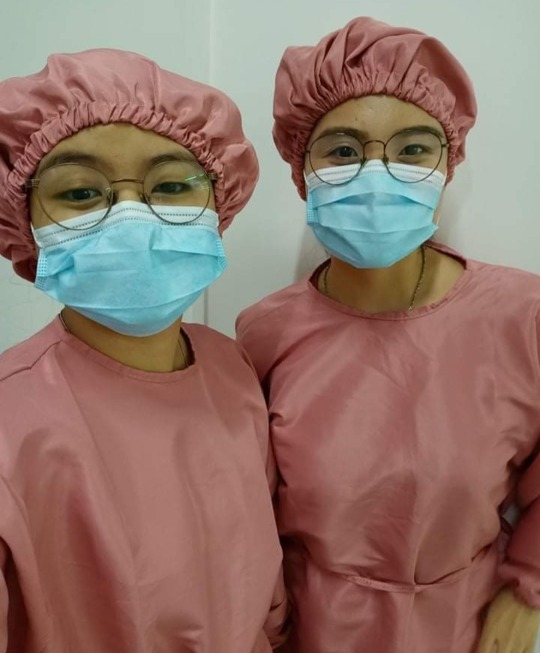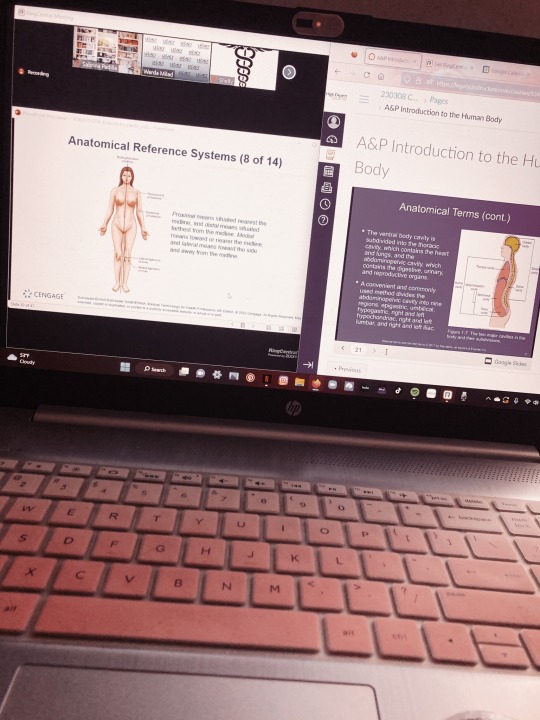#HealthCareWorkers
Explore tagged Tumblr posts
Text

Work lyfe
#self#me#theelementaryparticles#medical biochemistry#medical pathology#immunofixation#medical laboratory science#medical labs#laboratory medicine#medical laboratory technologist#laboratory#healthcareworkers
3 notes
·
View notes
Text
Well I've been daily updating twitter ofcourse. I kind of at the last moment decided I was going to do a daily doodle thing. I did this years ago, where I drew something every day for a year. I'm not doing a full illustration this time just really simple, essentially a couple lines and thats it. Just to help the creative juices flowing. I probably wont stick it out for an entire year but I keep getting myself backed up into an artistic corner and I want to back back out of it and find a new corner. Instead while I've been doing that, I've also been using it as an excuse to update the status of my current ailment.

so essentially, I had already self-diagnosed myself with the flu but I did go ahead and made an urgent care appointment on Saturday (?). I will say that I normally get a flu shot, every year, I did not get one this year. Next year I will definitely be getting one. I definitely got this from my coworkers and theres was like 3x milder than mine. My immune system was not prepared.
I did not want to physically go to urgent care because I didn't feel safe driving. I was super short of breath and I felt very drunk (because its in my ears! my ears are messed up). Also, didn't want to sit in a waiting room when sitting up sounded like a lot of effort and besides, what is urgent care going to tell me that I dont already know? viruses are treated with rest and fluids and thats it. However, I assumed my boss was going to be on top of me for some sort of a work note even though I'm not a full time employee and I dont feel like I should need one but I had agreed to work on monday and if I called in she'd probably pitch a fit. I discovered, thanks to the local spouse groups, that there was a local mobile urgent care. They came to my house! I schedule an appointment and they came out about an hour later. The most convenient thing ever. They apparently didn't take my insurance so they charged me 179$ out of pocket but I wasn't going to complain. I didn't have to go anywhere. I could track the MA on gps and they sent me his photo so I didn't "have to be scared" lmao. It was all very nice.
I had already tested myself for covid and it was negative. I was tempted to start myself on prednisone (because I practically have an entire pharmacy at home) but HR was a good 115 and adding steroid to that sounded not fun. Normally my HR runs 60s if Im calm and 80s if Im stressed. 115 with steroids on board didn't sound like fun. My 02 was dropping to 93 when I was up and walking around but it would go back up to the high 90s. This poor MA came with a laptop that virutally connected to a PA and they were like "what do you want me to do for you?" like I guess I mainly just wanted to make sure that I was safe to be at home and I have evidence I saw some sort of healthcare person as proof.
I oddly enough didn't have much of a cough until about yesterday. I was feeling short of breath and when I did cough I'd cough gunk up but mainly it just hurt to cough but it wasn't frequent at all. Now I'm coughing alot. The worst part was the hot/cold flashes. I completely drenched the bed in sweat. I've never seen that much water come off of me. I literally touched the valley of my stomach and it was a puddle. I splished my hands in it. I would alternate between uncontrollable sweating to then freezing to death. I thought I'd be over it and I washed all my linens yesterday and then last night, just sweat everywhere. Which was annoying because I felt....nagged..?..guilttripped? to go into work today by my boss. Like I was faking it..I couldnt possibly be sick that long(my coworkers recovered in 2 days)..maybe I was crazy and I wasn't sick?
so I did! I WENT TO WORK TODAY. My coworkers were actually fine. They said they were actually surprised they handled things well without me. I'm simultaneously proud of them and really aggravated that I went in. Because I really did feel terrible. I realized real fast how weak I was and my brain was not functioning. I even gave myself the easiest roll I could where I was off in a corner away from people and I was struggling. I was struggling to walk and I was struggling to stand. My partner at work let me know how bad I looked too. I apparently looked like a frail old lady. Which was nice.
So I went home. My boss is like "wait where you going?". I guess in her defense she came equipped with a bunch of throat lozenges for me but I didn't have a sore throat. I have no energy and cant breath. So I'm going home. I dont work tomorrow btw.
4 notes
·
View notes
Text

studying for an exam :)
#cardiac sonography#cardiac sonography student#cardiachealth#sonography#sonography school#ultrasound#echocardiography#health care student#healthcare#health#healthcareworkers
8 notes
·
View notes
Text
Be the Boss: Style Clothes for Assist You on Any Task of You Lifestyle, Anytime!
Clothes made to assist you with your busy day🤗. This is the height of fashion meets function!! Trust me once you try it you would never go back.
See more at https://www.scrubhaven.com/collections/best-scrub-brands

#barco#graysanatomy#graysscrubs#scrubhaven#healthcareworkers#healthcare#nurse#nurses#doctors#nurselife#healthcareprofessional#doctor#hospital#health#nursesofinstagram
6 notes
·
View notes
Text
The Strike Movement in Health Care
Observations On the Political Economy of Care and the Need for Class Organization

Since the start of this year, there has been continued resistance to further attacks to public health and to the poor staffing and pay for health care workers, but in a dispersed and disunified form.
Residents and interns at Mount Sinai in New York City went on strike, nurses in California went on strike across Oakland and Berkeley went on strike, and now nurses at Rochester General Hospital in New York will likewise go on strike. Since 2020, stoppages in the health care sector have made up 50% of all workers out on strike—a fact kept out by the media monopolies just as it lauds these same “heroes.” It is necessary to assess this situation to give force and continuity to the struggle.
The balance of force between the workers in the hospitals on the one hand and the government, the labor boards, the union bosses and the hospital administration on the other is not favorable to the former in this current conjuncture. This all must be taken into account when looking at the project of restructuring being carried out by management, with layoffs and hospital closures picking up along with an unprecedented trend towards monopolization within the sector.
This trend presents workers with restructuring based on the following: mobility, division, increase in the pace and speed of work with already limited staff, and the consequence of poor health care that comes with it. This is how the bourgeois intends to economize, making us available to be moved anywhere and to once.
What will also be discussed is how opportunism, through the bosses of the health unions and the Democratic Party, has helped to promote pacifism and class reconciliation in the face of increased militarization against health care workers. Without this implicit threat of violence and persecution for striking they wouldn’t be able to maintain this crisis. There has to develop a capacity towards a General Strike which repudiates those who push conciliatory agreements and that rejects the linkage to the State, and that demands a reversal of those “reforms” that attack the working class as a whole.
THE CRISIS FACING THE HEALTH SYSTEM
There have been decades of attacks on public spending in Medicare, Medicaid and other public health insurance programs, as the State has moved to privatize public insurance as well as it’s few remaining places of provision and to assist in the monopolization and concentration of the health care industry into the smaller hands. This restructuring uses the language of “reduction of inpatient hospital care” and “reversing high utilization rates,” all representing the squeezing of the working class when they come in as patients, but also representing work-speedups on staff as the unrelenting pressure to decrease the length of stay and to work more patients relative to the total number of workers on a unit in a given shift is pushed.
There is sentimentality in discussing what health care use to be like, though there is no need to nurse the wound of yearning for something thrown temporarily as a scrap. In the post-WW2 period, U.S. imperialism became the dominant political and economic bloc. It exported capital to the oppressed countries to generate super-profits and through the over-exploitation of the workers there, was able to provide a very privileged layer of workers higher wages and superior health care plans: this was the labor aristocracy. Through the expansion of commercial, employer-based coverage for these more privileged workers, as well as through the establishment of the public insurance system, new hospitals were constructed and bed capacity was expanded. However, this period ended/continues to end, with the general rate of profit pushing downwards in spite of the surplus value extracted from the dominated countries, making it no longer possible for capital to allocate significant amounts of money to public health. This represents a break from the welfare and self-legitimization policy which characterized the imperialist state’s approach in that expansionary period (the “liberal” period).
The decrease in available beds and staffing has worsened with each and every successive economic crisis and each consolidation of a smaller health system by a larger one. This period of imperial decline has meant an ongoing, painful process of limiting care for all who can’t afford it, particularly for the lower classes. According to the American Hospital Association, the number of inpatient hospital beds declined by an extraordinary 39% between 1981 and 1999. The purpose was to raise profits by increasing ‘census’ (the number of occupied beds) while also rushing to empty those few remaining beds. It was also focused on hospitalizing only for specialized procedures, while ignoring admitting for other more general needs, even if the latter could result in more acute problems if left unattended to. But management’s goal of 90% occupancy meant that hospitals no longer had the capacity to absorb patient influx when COVID-19 first hit.
2020 in the USA will be a year never forgotten by anyone: unemployment reached close to 17 millions in just 3 weeks, with the application for unemployment insurance reaching over 10 million. This unprecedented loss of jobs as a result of the crisis in overproduction, and years of disinvestment by the government from health care, came with the introduction the novel COVID-19 virus, which served as an element of destruction of the productive forces as a biological weapon of the ruling class. How did the virus serve the bourgeoisie in this way? Faced with capitalism’s overproduction crisis, where ever increasing portions of the population are surplus to capital, unable to be used as a workforce reserve or as consumers, permitted the virus to be weaponized to eliminate that part of the population. Indeed, by the “end” of the COVID-19 emergency order, 2.6 million more workers had “disappeared” from the labor market.
With even the capitalist media unable to ignore the death toll and the struggles of health care workers as they protested the scarcity of PPE on their units, the State was forced to make concessions to ameliorate the situation by temporarily suspending the usual medical-industrial and insurance rules of patient billing and reimbursement, and also provided subsidies to the for-profit hospitals and clinics to make up for their losses in suspending such rules. The waiving of all sorts of rules boosted coverage for patients, and was paid for with CARES Act funding and advanced Medicare payments.
However, this peace came to an end as the economy was declared to be entering a period of relative stability—and with that stability, these subsidies ended. By 2022 hospitals came complaining to Congress – as inflationary pressures started to pick up, there was a 184.57% loss in their operating budgets. In a report by Kaufman Hall they found that the median operating margins for about 900 large hospitals in the first half of that year were negative and lower than prior years. Kaiser Permanente in California reported a loss of $4.5 billion, and UPMC in Pennsylvania reported that they had lost $916 million. The largest cost in that period: labor costs and continued occupancy of beds In health care, while the provision of services is done privately in “nonprofit” hospitals and revenues are sopped up privately as well, they are dependent on increased State collaboration and support to enact their plans of squeezing more from workers and patients.
Pressured by this and needing to maintain the maximum profit for their health care monopolies, the imperialist State, through their corporativist levers within the health care industry, has now decided to suspend reforms that are now too costly for the capitalists. What was permitted to exist for the 26 months that the COVID emergency order was in place was to be now over. What forms does this new period of attacks appear as?
Hastening the general move from the hospital as a place where people are diagnosed or expected to recover -> to skilled nursing, inpatient acute rehab and “long term care hospital” facilities instead
They are introducing greater mobility, job combinations, speed ups, and increased intensity of work as a response to lower staffing, and are putting in hiring freezes
The greater use of military and police management of strikes in partnership with union leadership
“DEHOSPITALIZATION”
The entire discussion in medical policy circles about “length of stay” promotes the “dehospitalization” status quo as it stands and is pushed by hospital administration—it is a form of rationalization of health care labor, seeking to not just catalog all the motions of hospital workers and timing them to devise the most “efficient” flow of motion possible, but to also diminish preoperative and recuperative days that patients have. If, through straining existing staff on a unit, it is possible for 4 RNs and 2 nursing assistants to have 24 patients and discharge all of them under 10 days, then that is all the floor will have, and it will be management’s expectation that within that given abstract period of time, such an allocation of labor will produce that result.
The previous model as conceived in a hospitalization period for surgery patients would consist of 1) a period prior to intervention which consisted of diagnostic investigation; 2) the period of the intervention itself; 3) the post-operative period in which the patient was rehabilitated and then discharged. Today the 1) and 3) period are increasingly offloaded to “med-express” clinics and nursing facilities for each category, respectively. The diversion from this old model can be seen with how coronary artery bypass grafting (CABG) procedures are done. The period of recovery from this procedure use to be a week or more, today nurses, therapists and social workers document and track a 3 day post-operative period, with the expectation that on day 3 or 4 the patient will have their estimated discharge date.
The much vaunted “preventive health” policies which the government promotes has translated into a greater restriction of the already deplorable levels of assistance with which workers can access outside of the hospital. Corresponding to the reduction in the number of inpatient admissions and the worsening of the already precarious state of patient services has been a progressive reduction in employed staff and requalification (with all the effects this entails for us) in a forced march of hospital workers who can be utilized in the most functional way.
Reducing the “LOS” (Length of Stay) has now been a key indices judging the productivity of workers in health systems as they enlarge to buy out more hospitals and clinics.
MOBILITY AND DIVISION
Mobility can be seen as an instrument of the bourgeoisie in dividing and dismembering our workplace to make for the most efficient use of our labor power for the objectives of our bosses. When used here it is not just meaning to literally be ‘mobile’, to move, it means making the labor force more elastic and to give it multiple duties to do at once. Mobility is used because they will never want to increase the total number of workers, but want to make the most efficient use of the limited number already employed.
This is done most popularly, internally, through deciding to “float” nurses to other units within a given shift, even if they are not familiar with the patients on that unit. They are rushed to fill the plugs of an increasingly understaffed hospital. This is done by mandating overtime which is done, again, to similarly not have to hire more. Nurses are finding themselves working in units where the amount of assistance required by those with serious illness and in need of treatment is ever increasing while the workforce is cut closer to closer to the bone. Consequently, the constant physical effort, from the perspective of worker’s own health, overtime results in occupational illnesses.
In fact, this means of mobility (the use of an enormous mass of overtime hours) is a major method of mobility. Even in “unionized” hospitals their contracts do not enforce maximum limits and instead introduce provisions on the possibility of forcing workers to perform obligatory overtime, further enabling administrators to cover the chronic personal deficiency in each unit without having to hire even one more proletarian. Who knows how many new jobs could be generated with the amount of overtime hours nurses work!
Another method of mobility is the use of nursing assistants and nursing students. If clinical coordinators who compile shift schedules know that trainees or less trained staff are available on a given day, they immediately busy themselves letting other managers know that nurses have “excess rooms.” These younger workers have a precarity in their role, which is expressed in their selection to do the more physical work of direct care (assisting in bathing patients, taking them to the bathroom, helping patients transfer from bed to seat, etc), in the potential of expulsion from school if they display defiance or disagree to do certain tasks.
Likewise, for environmental services workers, the precarious positions they find themselves in as the rush to empty the hospital takes place is very apparent in their limited staffing and rush to fill rooms: health care workers know very well what it means to do wound care and place a central line in a room that has not been appropriately disinfected! The savings of the hospital are being made at all of our expense. This concerns not only hospital workers but also that of all the workers, particularly those inactive ones who are permanently disabled or retired, who are taken ill. In the precarious hygienic situation created by management, they end of contracting other illnesses. The cry of “length of stay” is made into a self-fulfilling prophecy – “because of our drive to empty beds and cut staff, we can’t keep our facilities clean enough, so you are endangered just by staying here!”
This is also done by dividing the workplace— hiring travelers and per diem RNs for temporary periods. While this use to be lucrative (and in some areas, still is) the disappearance of subsidies has resulted in many travel nurses having their pay with their new contracts reduced significantly. It is done by the hiring of Licensed Practical Nurses (LPNs) and Nursing Assistants and re-assigning/combining their roles to be more expansive, while RNs are increasingly entering clinical information to EPIC on computers while retaining the need to follow their patients closely. These divisions within the hospital professionally create discord and are attempts to foreclose on unity between health care workers, when some are paid greatly more in spite of doing the same work as others.
Within hospitals and across the health care system itself there is an aggravation of the differences in pay and privileges as a result of “dehospitalization” creating different tiers in the reproductive chain outside of hospitals as well. In nursing facilities and inpatient rehab, as well as home health and personal care agencies, where patients convalesce for longer periods at and more direct care occurs, there are often less skilled and thus lower paid workers. It is coincidentally here where the aged and highest acuity patients are also stored, who invariably are treated like objects in a storagehouse in no large part because of the deliberate disinvestment from this tier and the chronic cutting of staff from here as a result of the lower wages. While the largest health systems are where there has been the largest health care strikes in the last year, in a majority of states in the USA, the greatest number of health care workers on strike on a state-by-state level have been at nursing homes.
MILITARIZATION OF HEALTH CARE
The activation of the National Guard and Defense of Defense (DoD) for major strikes has ramped up to an alarming level, with unprecedented coordination among companies and the State to ensure that armed scabs are safely brought in. Under the guise of “disaster readiness” during COVID-19, militarization has been the decisive weapon for the imposition of the project of restructuring that we’ve described above. To understand how it has become standard practice and permeated the whole of the sector, means to take account of a transformed situation. The margins by which opportunists have deluded themselves that the interests of the proletariat can be advanced, that “democratic spaces” can be used, has been transformed or wiped out by the ongoing crisis—and the deployment of armed forces is proof of this.
2020-2022 in particular saw the development of a strong movement determined to conquer back much of what was lost over the years, with the use of police detectives, Pinkertons (private security), and National Guardsmen representing the bourgeois apparatus consolidating itself around a project of political and physical circumvention of health care workers and their organization. Yet even among “socialists” there isn’t a single action (beyond a strongly worded statement or complaint) shouted at the Democratic and “progressive” governors who have often been the face of this project.
All the most advanced proletarians in the health care sector must act decisively to come to terms with this reality, if they want to be capable of facilitating the rebirth and the renewal of the struggle against restructuring under the prevailing conditions. It is necessary to build a stable organization of struggle, protected as much as possible from the blows of repression, which implements--from within the unions and from without—a worker program by all means at the level of the current confrontation and within its relations of force. This is not about adventurist posturing, or organizing the struggle around certain objectives without adequately preparing the workers for the consequences of implementing those objectives, but of building organization which can impose the proletariat’s right to health care.
TOWARDS CLASS ORGANIZATION
There must be formed proletarian organization which reasserts the need for unions and other health organizations which are class conscious and combative—struggle committees (SCs) would be this form. They could serve as a point and network of discussion (investigation, concrete analysis), of organization and of struggle around the content of a workers’ program that seeks to settle accounts with the ongoing process of restructuring not just locally (through its application in the many hospitals we work in), but nationally on a political stage. These can serve the function of what is needed in each workplace—all of which are being subjected to the “reforms” described above.
There are many demands that can be taken up in this period which can be turned into slogans: Fight Mobility, Fight Mandated Overtime, Tools Used to Intensify Exploitation and Maintain the Hiring Freeze! Equal Pay for Equal Work-Fight the Wage Differentiation Policy!
Fight against the miserable enforcers of anti-proletarian policies, who have taken raises and management positions to act as the lapdogs of management as they implement the capitalist directives for restructuring health care. They are part of a capillary network of command and control in the hospitals.
Fight against surveillance and systematic checks to our timecards for the slightest infractions of being seconds to a minute over, fight the “real-time tracking systems,” which serve not to keep patients safe but to harass and harm the “dangerous” elements on our floor who don’t bow down before the exploitation of the company.
Build up the ability to deal heavy blows against the command control of the apparatus, build the maximum extent of strength and unity through the front organizations of health care workers (the revolutionary unions and committees).
Build links with all democratic and communist militants in SCs countrywide, until replicated in every hospital and able to breathe life into a new front nationally that can coordinate larger struggles. Relentlessly fight and regain life and form with a strategic perspective in mind, doing political education and applying it to planning. Through building strength, make the objectives of a new program that aims to defend ourselves and our patients from the for-profit health care that stems from the old society around us, with it’s repulsive relations of production, of production based on exchange value. Impose the proletarian right to health care.
3 notes
·
View notes
Text
Five years working as a dentist.
Four years of managing our own clinic, one year of preceptorship training and so much more to learn in this field.
Plus the pandemic, which makes our job one of the most at risk for infection. 🥂🥂🥂








3 notes
·
View notes
Text
#healthcare#healthcareworkers#healthcareheroes#selfcareishealthcare#healthcareprofessional#healthcareforall#naturalhealthcare#homehealthcare#thankyouhealthcareworkers#healthcareworker#mentalhealthcare#healthcareprofessionals#oralhealthcare#healthcaredesign#holistichealthcare#healthcareprovider#universalhealthcare#womeninhealthcare#abortionishealthcare#healthcaremanagement#healthcareadministration#healthcaremarketing#healthcarejobs#freehealthcare#affordablehealthcare#alternativehealthcare#healthcareassistant#womenshealthcare#healthcareers#healthcareisahumanright
2 notes
·
View notes
Text
The 16th International Healthcare, Hospital Management, Nursing, and Patient Safety Conference: A Comprehensive Overview
In the ever-evolving field of healthcare, platforms for collaboration, knowledge exchange, and innovation are critical to addressing global challenges. The 16th International Healthcare, Hospital Management, Nursing, and Patient Safety Conference promises to be one such pivotal event, bringing together leading professionals, researchers, and policymakers to discuss pressing issues and chart a path toward better healthcare systems. Here's a detailed exploration of what this conference entails, its benefits, and why it’s a must-attend for stakeholders in the healthcare sector.
Overview of the Conference
The 16th edition of this prestigious conference is scheduled to take place on [insert date] in [insert location]. The event serves as a hub for thought leaders and innovators in healthcare, focusing on hospital management, nursing, and patient safety—key pillars of an effective healthcare ecosystem.
With a rich agenda featuring keynote speeches, panel discussions, workshops, and poster presentations, the conference aims to:
Address emerging trends and challenges in healthcare delivery.
Showcase advancements in hospital management and nursing practices.
Highlight strategies to enhance patient safety across diverse settings.
Foster international collaborations for sustainable healthcare development.
Key Themes and Topics
The conference's agenda will encompass a broad range of topics, ensuring relevance for attendees from various specialties. Some key themes include:
Innovations in Hospital Management:
Leveraging technology for efficient operations.
Strategies for cost-effective healthcare delivery.
The role of data analytics in decision-making.
Advancements in Nursing Practices:
The integration of evidence-based practices in nursing.
Addressing workforce challenges in nursing.
Training and education programs for skill enhancement.
Patient Safety and Quality Care:
Reducing medical errors through improved protocols.
Implementing patient-centered care models.
Use of AI and robotics in enhancing patient safety.
Global Health Challenges and Solutions:
Managing pandemics and healthcare crises.
Addressing disparities in healthcare access.
Policies and frameworks for global health equity.
Benefits of Attending
Attending the 16th International Healthcare, Hospital Management, Nursing, and Patient Safety Conference offers numerous benefits for participants:
Networking Opportunities: The conference provides a platform to connect with industry leaders, researchers, and policymakers. Such interactions can lead to collaborations, partnerships, and shared insights that drive innovation.
Knowledge Sharing: Attendees gain access to the latest research findings, case studies, and best practices in healthcare. This knowledge can be directly applied to improve operations, patient care, and safety standards.
Skill Development: Interactive workshops and training sessions equip participants with practical skills, ranging from leadership in hospital management to advanced nursing techniques.
Professional Recognition: Presenting at the conference or having your research featured elevates your professional profile and establishes you as a thought leader in your domain.
Staying Ahead of Trends: With sessions dedicated to emerging technologies and future trends, attendees stay ahead in an industry characterized by rapid evolution.
Conference Key Sessions:
Nursing in Healthcare | Nursing & Health Sciences | Healthcare Simulation | Home Care Nursing Services | Advanced Healthcare | Types of Nursing in Healthcare | Public Health Nursing | Healthcare Leadership | Healthcare Management | Hospital Management | Internal Medicine | Pharmacology | Psychiatry and Mental Health | Healthcare Quality |
Engaging Features of the Conference
To ensure an enriching experience, the conference integrates several engaging elements:
Keynote Speeches: Delivered by globally recognized healthcare experts, these sessions provide deep insights into critical topics.
Interactive Panels: Panels allow for real-time discussions and Q&A sessions, fostering a dynamic exchange of ideas.
Exhibition Stalls: Leading organizations will showcase cutting-edge products, technologies, and solutions.
Poster Presentations: These highlight innovative research, offering a visual and concise overview of groundbreaking studies.
Awards and Recognition: Outstanding contributions to healthcare are celebrated, motivating participants to strive for excellence. Target Audience/who should attend/ who you can network with
Nurses, Doctors, Professors, Registered Nurse, Practitioner Nurse, Student Nurse, Academics and Researchers. Students of medicine disciplines. Clinicians. Specialists in Patient Safety and Quality Healthcare, Chief nursing officers and nursing staff, Quality and compliance officers, Infection control officers, Risk management personnel, Patient Safety Officers/Patient Safety Managers, Managing Directors/ Department Managers, Quality Management Professionals/Quality Improvement Managers/Quality Assurance Professionals/Managers, Risk Managers, Infection Perfectionists, Infectious Disease Consultants, CSSD (sterile service) Managers/Supervisors/ Technicians, Clinical Lead/Senior Clinical Health practitioner/Head of clinical service delivery, Head of Education and training/clinical lead for training and development/director of HR, education and Training, General practitioner, pharmacist, Patient representatives, Academic- including researchers, professors, and students, Patient safety lead/Patient safety manager/head of quality/Quality lead/manager of quality improvement, infection prevention lead. Submit Your Abstract: https://nursing-healthcare.utilitarianconferences.com/submit-abstract
Factual Data and Insights
The healthcare industry faces several challenges, from increasing demand due to aging populations to navigating the complexities of digital transformation. Consider these statistics:
Global Healthcare Expenditure: According to the World Health Organization (WHO), global healthcare expenditure reached $8.5 trillion in 2022, underscoring the sector’s economic significance.
Nursing Workforce Shortage: The WHO estimates a shortfall of 5.9 million nurses worldwide, highlighting the urgency of addressing workforce challenges.
Patient Safety Concerns: Studies show that 1 in 10 patients experiences adverse events in hospitals, emphasizing the need for improved safety protocols.
Tips for Attendees
To make the most of the 16th International Healthcare, Hospital Management, Nursing, and Patient Safety Conference, consider the following tips:
Plan Your Schedule: Review the agenda in advance and prioritize sessions that align with your interests and professional goals.
Engage Actively: Participate in discussions, ask questions, and share your perspectives to enrich the experience for yourself and others.
Network Strategically: Bring business cards and be proactive in initiating conversations with fellow attendees.
Leverage Technology: Use the conference app to stay updated on session timings, speaker details, and networking opportunities.
Follow Up: After the conference, follow up with contacts made and implement learnings in your work setting.
A Call to Action
The 16th International Healthcare, Hospital Management, Nursing, and Patient Safety Conference is more than an event; it’s a movement toward transformative change in healthcare. Whether you are a healthcare administrator, a nurse, a researcher, or a policymaker, this conference provides an unparalleled opportunity to contribute to and benefit from the collective wisdom of the global healthcare community.
Register today and be part of shaping the future of healthcare. Together, we can ensure safer, more effective, and equitable healthcare systems for all. Important Information: Conference Name: 16th International Healthcare, Hospital Management, Nursing, and Patient Safety Conference” from September 9-11, 2025 | Lisbon, Portugal Short Name: 16IHNPUCG2025 Dates: September 9-11, 2025 Venue: Lisbon, Portugal Email: [email protected] Visit: https://nursing-healthcare.utilitarianconferences.com/ Call for Papers: https://nursing-healthcare.utilitarianconferences.com/submit-abstract Register here: https://nursing-healthcare.utilitarianconferences.com/registration Call Us/What Sapp Us: +447723493307
#Nursing#HospitalManagement#Healthcare#NurseLife#MedicalCare#HealthAdministration#NursingCare#HospitalStaff#HealthcareManagement#MedicalProfessionals#NursingLeadership#PatientCare#NurseLove#HealthcareHeroes#HospitalLife#NursingCommunity#HealthCareWorkers#NursePractitioner#HospitalAdministrator#MedicalManagement#NursingEducation#HealthcareLeadership#NurseSupport#MedicalStaff#NursingInnovation
0 notes
Text

CALL FOR SPEAKERS "The world is waiting for your voice—join as a speaker." join us now at the CME/CPD accredited 15th World Healthcare, Hospital Management, Nursing, and Patient Safety Conference from May 14-16, 2025, in San Francisco, USA. Register Now: https://nursing.utilitarianconferences.com/registration Registration Deadline- January 15, 2025 #NursingCare #HealthCareHeroes #PatientCare #MedicalProfessionals #HealthcareWorkers #NurseLife #HealthMatters #CompassionateCare #NursingStudent #MedicalField #NursingGoals #WellnessJourney #HospitalLife #NursePractitioner #PublicHealth #CareWithCompassion #NursingLeadership #HealthcareInnovation #NursingEducation #HealthAndHealing
#NursingCare#HealthCareHeroes#PatientCare#MedicalProfessionals#HealthcareWorkers#NurseLife#HealthMatters#CompassionateCare#NursingStudent#MedicalField#NursingGoals#WellnessJourney#HospitalLife#NursePractitioner#PublicHealth#CareWithCompassion#NursingLeadership#HealthcareInnovation#NursingEducation#HealthAndHealing
0 notes
Text
anyone work in healthcare and then see a cool name u can’t share bc it’s healthcare. Like damn [REDACTED] is such a cool name y’all. I’ll be thinking about [REDACTED] for the rest of my week.
1 note
·
View note
Text

Doing nerd stuff.
#theelementaryparticles#self#me#medical biochemistry#medical laboratory technologist#medical pathology#microscope#healthcareworkers#hospital#laboratory medicine#laboratory
4 notes
·
View notes
Text

this is what every morning of my life is now :)
#anatomy and physiology#anatomy#anotomical#sonography#cardiac sonography#cardiachealth#health#healthcare#healthcareworkers#ultrasound#sonographer#sonography school#cardiac sonography student#sonography student
4 notes
·
View notes
Text
The Lecton: Always Make An assumption.
I started wearing my stethoscope around my neck in case of a medical emergency so people learn a lesson on never making assumptions😉.
On a side note - We now offer engraving options for stethoscopes.
Visit us at https://www.scrubhaven.com/

#scrubhaven#healthcareworkers#healthcare#nurse#nurses#doctors#nurselife#doctor#hospital#medical#health#nursesofinstagram#medicine#nursing#healthcareprofessional#nursesrock#registerednurse
3 notes
·
View notes
Text
Transform Your Charge Capture Process with maxRVU
Managing charge capture can feel like a hassle for healthcare professionals. Missed charges, billing errors, and time-consuming paperwork can take focus away from what matters most—your patients. That’s where maxRVU steps in.
Here’s how maxRVU can make your life easier:
Why Choose maxRVU?
Log Charges Instantly Use your smartphone or tablet to capture charges in real-time. No more forgetting services or end-of-day paperwork!
Simplify Workflows Seamlessly integrates with your existing systems—no disruptions, just smoother operations.
Maximize Revenue Stop losing money to missed charges. maxRVU ensures every service is accounted for.
Easy to Use Intuitive and user-friendly, so you can start using it with minimal effort.
Secure and Compliant Your data is safe with maxRVU’s top-tier encryption and compliance with healthcare regulations.
Benefits You’ll See
Save Time: Focus on patients, not paperwork.
Increase Accuracy: Fewer errors mean fewer billing headaches.
Boost Revenue: Capture every charge and maximize reimbursements.
Ready to Get Started?
Switch to maxRVU and experience how simple and stress-free charge capture can be.
👉 Visit maxRVU to learn more and schedule your demo today!
maxRVU: Simplifying charge capture, so you can focus on care

#maxRVU#gingerCube#medicalbilling#health#healthcare#healthcareworkers#nurse#nursepractitoner#nurselife#doctor#doc#dr#md#doctors#med#medical#physician#pa#hospital#clinic#telemedicine#surgeon#orthopedicsurgery#radiology#oncology#internalmedicine#neurology#cardiologist#urology#anesthesiology
1 note
·
View note
Text
Top Questions Nurses Ask About Nursing Placement Agencies
Nurses who have intentions of engaging the nursing placement agencies should be educated in the processes benefits and disadvantages that come along with using them. They could be permanent jobs, temporary assignments, or flexible options. Nursing placement agencies have something to offer with these options. However, many do have inquiries before diving in. Below are some of the typical top questions that nurses ask about nursing placement agencies.

1. How do nursing placement agencies work?
Placement agencies for nursing provide an intermediary ground between the nurses and health care providers. The primary duty of the placement agency is locating proper placement according to a nurse's qualifications, preferences, and availability. They take care of most of the recruitment procedure, the job-seeking process, and interviews; sometimes, even deal with salary negotiations. To find their placement agencies, nurses come up with short-term or annual contracts or permanent placements offered by the agencies under such provisions.
2. Are there fees involved with using a nursing placement agency?
Hidden charges regarding the usage of the nursing placement agency are one of the biggest problems facing nurses. Reputable agencies will mostly not charge the nurse for their services. Rather, they get paid by the healthcare facility or employer for the successful placement of a nurse in a role. Nurses should always verify at the very beginning that no placement fees or hidden charges will be asked from them.
3. What are the benefits of working with a nursing placement agency?
In fact, there are many benefits to working with a nursing placement agency. The greatest of which, however, is in terms of really saving time and energy in searching for jobs. The agency will have access to numerous hospitals, clinics, and other healthcare facilities in nursing placement openings. Hence, they can easily find posts according to preference and skill balance. There are quite a number of them that offer flexible hours for nurses to decide when and where to work. Some may prefer variety and thus may want to be in a placement agency to have the experience of working in various health settings and understanding diverse fields.
In fact, agencies usually provide high pay, offers, and bonuses as well, which are attractive to most nurses, as they focus on maximizing their earning potential. They are also responsible for processing various forms of the coming paperwork and the compliance of licensing in ensuring that the qualified nurses are credentialed by the state's regulations.
4. Do nursing placement agencies offer benefits like health insurance or retirement plans?
Several nurses raise the query that working through placement agencies leaves them deprived of benefits. However, this is not quite true, as there are a number of agencies that do provide health insurance, retirement savings plans, and other benefits to contracted or temporary nurses. These benefits vary from agencies; so, nurses should always inquire about the provision of health coverage, paid time off, and retirement plans before committing to a placement. Some set up referral bonuses, continual education reimbursements, and other such incentives to lure and keep them.
5. How do I know if a nursing placement agency is reputable?
Research before signing with any nursing placement agency. Nurses should check for honest reviews and positive comments from other health professionals. Cross-reference the agency with peer recommendations; your colleagues’ or other nurses' recommendations can be priceless in identifying a reputable agency. Credible agencies are either accredited with certain industry associations or linked with big-name healthcare facilities. For example, nurses should also be wary of agencies that make unrealistic promises, such as job placements with guaranteed pay or false-high salaries without solid proof.
Conclusion
They're great opportunities for nurses to become flexible in their career paths. There are numerous job options, competitive salary packages, and flexibility made possible through a nursing placement agency. However, some key questions have to be asked by the concerned nurses regarding the fees, benefits, preferences associated with jobs, and agency reputation so that they can finalize the better option. It is possible for the nurse to decipher the entire profile of his agency, and it will enable the nurse to use the maximum features of such agencies and find the best job using services that suit him best-concerning career objectives. Partner with Alliance Recruitment Agency—your trusted partner in nursing placements! Contact us now.
#NursingPlacementAgencies#Nurses#HealthcareJobs#NursingCareers#NursingOpportunities#JobFlexibility#NurseBenefits#NursingRecruitment#HealthcareWorkers#NursingProfession#NurseJobs
0 notes
